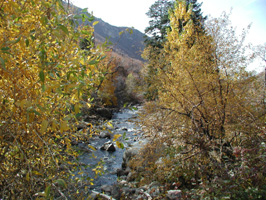New Water Year
Utah Water Users get water report
November 15, 2002
|
Admitting that long-range forecasting is risky business, Brian McInernery, hydrologist with the Nation Weather Service, said that the Pacific temperatures are changing towards an El Niño regime. “Not a big change, but things are changing,” he said. This could result in the northern United States getting warmer and wetter. As for Utah the fall forecast is normal temperatures and precipitation in the north and wetter than normal in the southern part of the state. This winter looks warmer in the north with warmer temperatures and drier in the south. The spring is forecasted to be normal to wetter.
September precipitation was around 150 percent of normal providing much need water to replenish the depleted soil moisture. October’s precipitation was not as good, but above normal. According to snow survey supervisor in the U.S. Natural Resources Conservation Service Randy Julander, the soil moisture content has greatly improved over last year and will help the run-off next spring. The fall storms and improving soil moisture have improved Utah’s Palmer Index rating. Based on the criteria used in this drought rating, Utah is no longer in drought conditions. However, he noted that the there is a storage deficit. The state’s reservoirs, excluding Lake Powell lost nearly a million acre-feet of water in storage during the past year. “It’s going to take a number of years to fully recover,” said Julander.
The effects of the drought in the Upper Colorado Basin are strikingly apparent in the volume of water in Lake Powell. When full the lake holds 27 million acre-feet of water. The current volume is 14.2 million acre-feet. The water surface elevation is 76 feet below full pool. The run-off into Lake Powell this year was at an all time low at 3.1 million acre-feet. Historically the inflows vary between 6 and 22 million acre-feet. The Colorado Compact that allocated the river’s water to the 7 Upper and Lower basin states, used 17.5 million acre-feet as the amount of water to be divided among the states. The inflow in to the reservoir has decrease for three running years.
November 15, 2002 SNOWTEL data indicate that the state’s snowpack is slightly above normal in the north for this time of year. The snow water equivalent content is 142 percent in the Bear River, 119 percent in the Weber-Ogden Rivers, 103 percent in the Provo River -Utah Lake and Jordan River and 128 percent in the Duchesne River. The numbers are lower in the southern part of the state. The Sevier River is 85 percent of normal and the Virgin River 57 percent of normal.
